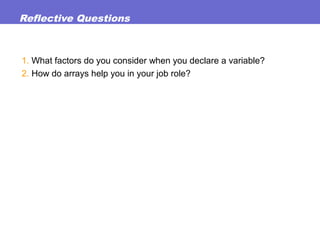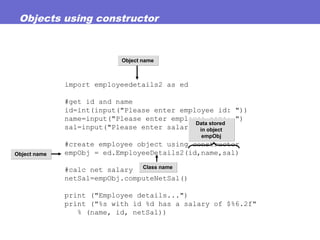Introduction to coding using Python
- 1. PYN101 – Quick Introduction to Coding Using Python www.ocdatabases.com slides.1@ocdatabases.com 949-489-1472
- 2. Quick Introduction to coding using Python • If you have not done so already please fill out your student questionnaire online as shown or submit them to your instructor • Enjoy programming in Python!
- 3. PYN101 Quick Introduction to Coding using Python • Introduction (s) • Facilities • Course Packet (May vary by course and class) – Student Questionnaire – Collaterals (Maps, Catalog, Etc.) – PowerPoint slide deck – Evaluation form – Training certificate
- 4. 4
- 5. Quick Introduction to Coding Using Python I. Introduction to Programming II. Creating Simple Programs III. Creating Programs Using Functions IV. Implementing the Object-Oriented Methodology V. Handling Programming Errors
- 6. I. Introduction to Programming History Programming Environments Overview of Programming Introduction to the Software Development Life Cycle
- 7. Copyright © 2011 Element K Content LLC. All rights reserved. History of Python
- 9. Program salary1=1000 salary2=2000 sum=salary1 + salary2 print("The sum of two salaries is: {}".format(sum)) isSal2Larger = salary1 > salary2 print("Salary2 is larger than salary 1: {}".format(isSal2Larger)) serviceYears1 = 10 serviceYears2 = 5 isYears2Longer = serviceYears2 > serviceYears1 print("Salary2 is larger than salary 1 because their years of service is longer: {} ". format(isSal2Larger and isYears2Longer)) Program Interpreter Results Program written in scripting language Program written in scripting language Program displays results Program displays results Instructions (statements) written in Python Instructions (statements) written in Python
- 10. Syntax Keyword used to create a class Keyword used to create a class Punctuation used to create a Statement block Punctuation used to create a Statement blockclass EmployeeDetails: #class methods #initialize instance variables def init (self, num, name, sal): self.empNo = num self.empName = name self.salary = float(sal) def computeAllow(self): return self.salary * 0.05 def computeNetSal(self): return self.salary - self.computeAllow() def getName(self): return self.empName Statements indented inside block Statements indented inside block
- 11. The Programming Life Cycle Coding Executing Debugging Program containing an error Program containing an error Instructions written in a scripting language Instructions written in a scripting language Internal BytecodeInternal BytecodeSource codeSource code
- 12. The Python Platform Process Edit Verify Load Interpret Phases in the Python platform process Phases in the Python platform process
- 13. The Software Development Life Cycle Maintenance Testing Analysis Software Development Life Cycle Implementation Development Design
- 14. Reflective Questions 1. Which programming methodologies do you suggest for your organization? 2. Will you follow the SDLC approach to developing software in your company? Why?
- 15. II. Creating Simple Programs Work with Variables Work with Operators Control Program Execution Work with Lists
- 16. Variables salary = 1750 if salary > 2500: print ("Salary is greater than 2500") else: print ("Salary is less than 2500") Variable NameVariable Name Value stored in the variable Value stored in the variable
- 17. Operators salary1=1000 salary2=2000 sum=salary1 + salary2 print ("The sum of the two salaries is %6.2f" % sum) Expression used to calculate the sum of salaries. The result always on the left. Expression used to calculate the sum of salaries. The result always on the left. OperandOperand Data used in the expression Data used in the expression The addition operatorThe addition operator
- 18. The if Statement salary = 1750 if salary > 2500: print("nSalary is greater than 2500") salary = salary + (0.03 * salary) Keyword used to create an if conditional statement Keyword used to create an if conditional statement Action StatementAction Statement Test conditionTest condition
- 19. The if...else Statement salary = 1750 if salary > 2500: print("nSalary is greater than 2500") salary = salary + (0.03 * salary) else: print("nSalary is less than 2500") salary = salary + (0.05 * salary) print("Adjusted salary: {}".format(salary)) Test conditionTest condition Keyword used to create if block Keyword used to create if block Keyword used to create else block Keyword used to create else block Statements to execute when the test condition returns true Statements to execute when the test condition returns true Statements to execute when the test condition returns false Statements to execute when the test condition returns false
- 20. The elif Statement if day == 1: print ("Monday") elif day == 2: print ("Tuesday") elif day == 3: print ("Wednesday") elif day == 4: print ("Thursday") elif day == 5: print ("Friday") elif day == 6: print ("Saturday") elif day == 7: print ("Sunday") else: print ("Invalid day value") Declared with the elif keyword Declared with the elif keyword Default statementDefault statement Repeated elif statements Repeated elif statements Test conditionTest condition
- 21. The while Loop counter = 10 i = 1 #while loop - tests before entering the loop #make sure the loop variables are initialized print ("Basic while loop") while i <= counter: print("i = {}".format(i)) i = i + 1 Statements to execute when the test condition returns true Statements to execute when the test condition returns true Declared with the while keyword Declared with the while keyword Test conditionTest condition Note: there is no do …while … in Python
- 22. The for Loop sum = 0 counter = 15 for i in range(1,counter+1): sum = sum + i; print("i = {}".format(sum)) Statement(s) executed while variable within sequence range Statement(s) executed while variable within sequence range Iterating variable declarationIterating variable declaration sequence expression sequence expression Declared with the for keyword Declared with the for keyword
- 23. Lists marks = [85, 60, 78, 73, 84] 1 2 30 6085 78 73 84 4 List elementsList elements List initializationList initialization List nameList name List IndexList Index Graphical representation of list Graphical representation of list
- 24. Multidimensional Lists salary2 =[[12000, 13000,14000], [10000,15000,2000]] tmpsalary = salary2[1][2] LIst IndexLIst Index 1300012000 14000 1500010000 20000 0100 02 1110 12 Value stored in the list element Value stored in the list element Graphical representation of a two-dimensional list Graphical representation of a two-dimensional list List elementsList elements LIst nameLIst name
- 25. Other data structures • Tuples t=(12,15,90) • Dictionaries d={“name”:”dan”, “phone”:123-456-7890”} • Sets • And more • We will cover these in our more formal programming classes • There are also modules for manipulating datasets and big data
- 26. Reflective Questions 1. What factors do you consider when you declare a variable? 2. How do arrays help you in your job role?
- 27. III. Creating Programs Using Functions Create Functions Work with Built-in Functions
- 28. Functions def calcNetSalary(allowance, sal): deduction = allowance/100 * sal print ("The deduction is ${:,.2f}".format(deduction)) netSal = sal - deduction return netSal Method bodyMethod body DeclarationDeclaration Method nameMethod name ParametersParameters
- 29. Function Calls def print_salary(): #initialize variables salary = 12000.0 print("The current salary is ${:,.2f}".format(salary)) #calculate net salary by calling a function netSalary = calcNetSalary(5, salary) print("The net salary is ${:,.2f}".format(netSalary)) #function to calculate the net salary def calcNetSalary(allowance, sal): deduction = allowance/100 * sal print ("The deduction is ${:,.2f}".format(deduction)) netSal = sal - deduction return netSal Function callFunction call Function declaration Function declaration
- 30. Importing modules import os print (os.getcwd()) print (os.listdir('.')) Import declarationImport declaration Function callsFunction calls The Python ecosystem includes a huge library of functions across many domains. This is one of Python’s strong points and is a major reason for its popularity.
- 31. Reflective Questions 1. In what ways does importing modules help you in your job role? Discuss. 2. Why would you prefer built-in functions rather than defining your own functions? Discuss.
- 32. IV. Implementing the Object-Oriented Methodology Create a Class Create an Object Create a Constructor Create a Subclass
- 33. Classes class EmployeeDetails: #class methods #initialize instance variables def init (self, num, name, sal): self.empNo = num self.empName = name self.salary = float(sal) def computeAllow(self): return self.salary * 0.05 def computeNetSal(self): return self.salary - self.computeAllow() def getName(self): return self.empName Methods in the class Methods in the class Class name preceded by the class keyword Class name preceded by the class keyword Instance variables Instance variables
- 34. Objects import employeedetails as ed #create employee object empObj = ed.EmployeeDetails() #get id and name id=int(input("Please enter employee id: ")) name=input("Please enter employee name: ") sal=input("PLease enter salary: ") #calc net salary empObj.init(id,name,sal) netSal=empObj.computeNetSal() print ("Employee details...") print ("%s with id %d has a salary of $%6.2f" % (name, id, netSal)) Object nameObject name Data stored in object empObj Data stored in object empObj Object used to store employee data Object used to store employee data data for employee data for employee Class nameClass name
- 35. The self Keyword class EmployeeDetails: #class methods #initialize instance variables def init (self, num, name, sal): self.empNo = num self.empName = name self.salary = float(sal) def computeAllow(self): return self.salary * 0.05 def computeNetSal(self): return self.salary - self.computeAllow() def getName(self): return self.empName Class nameClass name The self keyword used to access instance variables from within a method The self keyword used to access instance variables from within a method
- 36. Constructors class EmployeeDetails2: #class methods #constructor (initializer) with defaults def __init__(self, num=0, name='Unknown', sal=0.0): self.empNo = num self.empName = name self.salary = float(sal) def computeAllow(self): return self.salary * 0.05 def computeNetSal(self): return self.salary - self.computeAllow() def getName(self): return self.empName Class nameClass name Code to initialize the class Code to initialize the class Constructor parametersConstructor parameters ConstructorConstructor
- 37. Objects using constructor import employeedetails2 as ed #get id and name id=int(input("Please enter employee id: ")) name=input("Please enter employee name: ") sal=input("Please enter salary: ") #create employee object using constructor empObj = ed.EmployeeDetails2(id,name,sal) #calc net salary netSal=empObj.computeNetSal() print ("Employee details...") print ("%s with id %d has a salary of $%6.2f" % (name, id, netSal)) Data stored in object empObj Data stored in object empObj Object nameObject name Class nameClass name Object nameObject name
- 38. Subclasses from employeedetails2 import EmployeeDetails2 class ProjectMgr(EmployeeDetails2): #class methods #constructor (calls superclass) with defaults def __init__(self, num=0, name='Unknown', sal=0.0, sub=0): super().__init__(num, name, sal) self.numSubordinates = sub #override calculate net salary #replace allowance with bonus def computeNetSal(self): return self.salary + self.salary * 0.10 #new method to get nbr of subordinates def getSubordinates(self): return self.numSubordinates Keyword used to call superclass Keyword used to call superclass SubclassSubclass Parent (super) class Parent (super) class Default values for constructor Default values for constructor overidden methodoveridden method New method extends functionality New method extends functionality
- 39. Instantiate subclass import projectmgr as pm #get id and name id=int(input("Please enter employee id: ")) if id != 0: name=input("Please enter employee name: ") sal=input("Please enter salary: ") subs=int(input("Please enter # subordinates: ")) #create employee object pmObj = pm.ProjectMgr(id, name, sal, subs) else: pmObj = pm.ProjectMgr() #calc net salary print ("Employee details...") print ("%s with id %d has a salary of $%6.2f" % (pmObj.getName(), id, pmObj.computeNetSal())) print ("%s with id %d has a %d subordinates" % (pmObj.getName(), id, pmObj.getSubordinates())) Create pm object with arguments Create pm object with arguments Get values for constructor Get values for constructor Crate default pm object Crate default pm object Call methods,; note getName is in Call methods,; note getName is in
- 40. Reflective Questions 1. Discuss the advantages of using objects in your program. 2. In what ways does method overloading and overriding help you as you create software in your job role?
- 41. Quick introduction to coding using Python • Please fill out your evaluations online as shown or submit them to your instructor • Enjoy programming in Python!
Editor's Notes
- #5: The red arrow points to the training center. The yellow sunburst is the intersection of the Ortega Highway and Interstate 5, the route by which most students will reach the us.
- #6: OV #: Source File Name(s): Figure File Name: Comments:
- #7: OV #: Source File Name(s): Figure File Name: Comments:
- #15: OV #: Source File Name(s): Figure File Name: Comments:
- #16: OV #: Source File Name(s): Figure File Name: Comments:
- #27: OV #: Source File Name(s): Figure File Name: Comments:
- #28: OV #: Source File Name(s): Figure File Name: Comments:
- #32: OV #: Source File Name(s): Figure File Name: Comments:
- #33: OV #: Source File Name(s): Figure File Name: Comments:
- #41: OV #: Source File Name(s): Figure File Name: Comments:





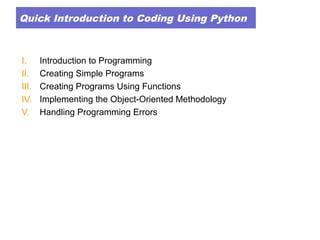
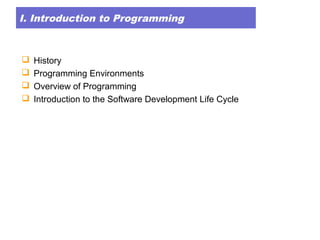
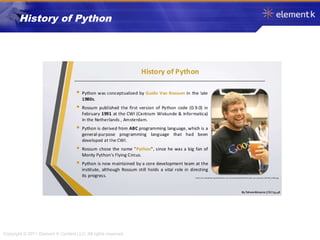
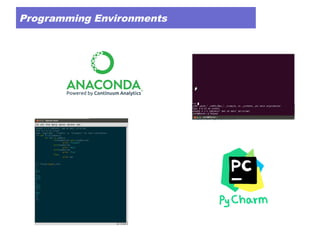




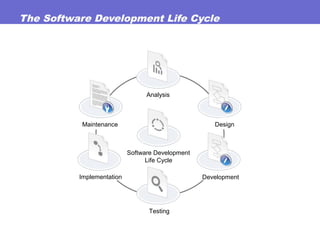








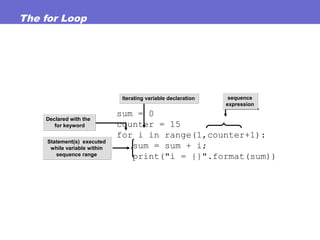
![Lists
marks = [85, 60, 78, 73, 84]
1 2 30
6085 78 73 84
4
List elementsList elements
List initializationList initialization
List nameList name
List IndexList Index
Graphical representation
of list
Graphical representation
of list](https://image.slidesharecdn.com/pyn101-170524215914/85/Introduction-to-coding-using-Python-23-320.jpg)
![Multidimensional Lists
salary2 =[[12000, 13000,14000], [10000,15000,2000]]
tmpsalary = salary2[1][2]
LIst IndexLIst Index
1300012000 14000
1500010000 20000
0100 02
1110 12
Value stored in
the list element
Value stored in
the list element
Graphical representation
of a two-dimensional list
Graphical representation
of a two-dimensional list
List elementsList elements
LIst nameLIst name](https://image.slidesharecdn.com/pyn101-170524215914/85/Introduction-to-coding-using-Python-24-320.jpg)

